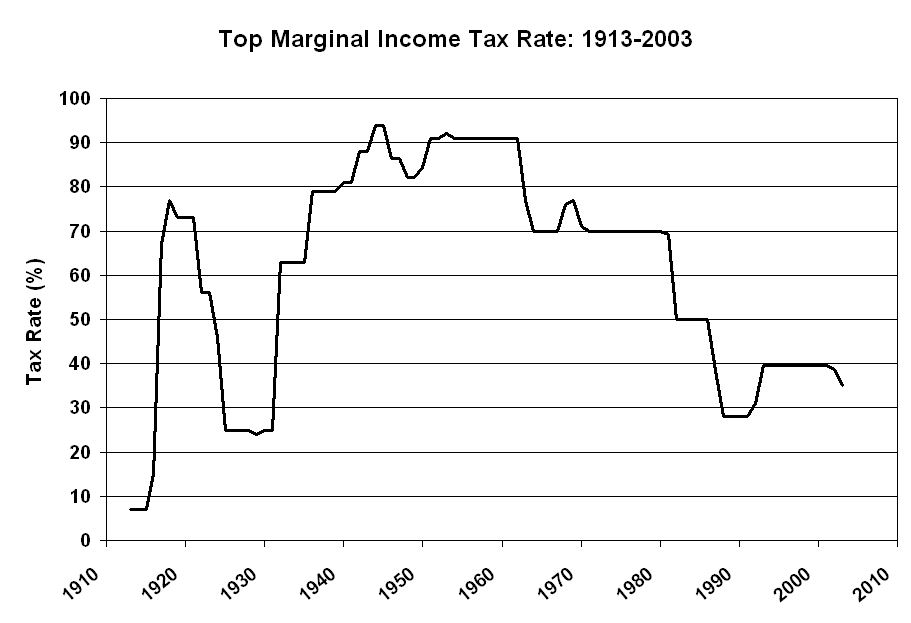The current debt problem, while serious, and certainly requiring broad-based sacrifice in both spending and higher taxes, is hardly a new challenge. After World War II, US debt levels were much higher than today--topping out at 120 percent of GDP. But over the next thirty years bi-partisan efforts led to a debt level that was only 25 percent of the peak, as shown on the chart above (from
here). How did 6 Republican and Democratic presidents successfully and dramatically reduce the national debt?
Simple, they raised sufficient revenue through high taxes to cover all government expenditures and pay-off the Word War II debt. As the chart below (from
here) demonstrates governing elites imposed marginal tax rates that reached as high as 92 percent to accomplish this.
What a difference responsible and farsighted governing elites that are willing to sacrifice for the betterment of their nation can make.





Because of the structure of the tax code no one paid income taxes at the 92% top marginal rate. No one :
ReplyDelete"The intelligentsia of the Democratic Party is growing increasingly enthusiastic about raising the highest federal income tax rates to 70% or more. Former Labor Secretary Robert Reich took the lead in February, proposing on his blog "a 70% marginal tax rate on the rich." After all, he noted, "between the late 1940s and 1980 America's highest marginal rate averaged above 70%. Under Republican President Dwight Eisenhower it was 91%. Not until the 1980s did Ronald Reagan slash it to 28%." ... This new fascination with tax rates of 70% or more is ostensibly intended to raise gobs of new revenue, so federal spending could supposedly remain well above 24% of GDP rather than be scaled back toward the 19% average of 1997-2007. ... But the individual income tax actually brought in less revenue when the highest tax rate was 70% to 91% than it did when the highest tax rate was 28%. ..." -- WSJ
"Where does this 60 and 71% tax rate in the 1960s come from? The basic fact of the Federal taxation is that it raises about 20% of GDP despite wild variation in the statutory tax rates. In 1960 Federal tax receipts (NIPA table 3.2) divided by national income (NIPA 1.12) were 93.9/2013.9 = 19.8%. In 2004 this ratio was 2013.9/10534.0 = 19.1%. Statutory tax rates in the 1960s were as much as 90% marginal rates on the highest incomes. (Remember George Harrison's "Taxman?" "One for you, 19 for me." He wasn't kidding.) But the tax code was so shot full of loopholes that the Federal government didn't collect nearly that fraction of income from anyone." -- Prof. John H. Cochrane, University of Chicago
The U.S. already has the most progressive tax rate structure in the industrialized world. Despite the constant cries from the left, the "rich" are shouldering more of the nations tax burden than at any time during the last 40+ years:
ReplyDelete"According to the Congressional Budget Office’s (CBO’s) report Average Federal Tax Rates in 2007, the higher income groups have consistently paid a disproportionately large share of the tax bill. The data show that the top 1% of all households paid 39.5% of total federal income taxes while earning 19.4% of total income in the economy. The top 20% paid 86% of total income taxes while earning 55.9% of total income. In contrast, the lowest quintile had a negative tax liability of 3.0% and an income share of 4.0%. This demonstrates that our current tax code is highly progressive and that the higher income groups actually pay more than a proportional share. Whether that is “fair” is in the eye of the beholder."
"The code’s progressivity is further demonstrated by effective tax rates. The effective rates on all federal taxes in 2007 were lower than in 2000 for all income groups. However, the biggest percentage drops occurred at the lower end of the income distribution. The average rate for the top quintile dropped by 10.4%, while the lowest quintile declined by 37.5%. The same trend holds if we just look at income taxes. The top quintile saw its effective income taxes drop by 17.7%, while the lowest quintile dropped 47.8%. ..." -- Free Enterprise
And the "wealthy" will not sit idlely bye as the parasitic left feasts on them:
"The chart above shows the relationship over time (from 1979 to 2007) between: a) the top marginal income tax rate, and b) the share of total income taxes paid by the top 1% (data). In 1979 the top marginal income tax rate was 70% and 18.3% of the total taxes paid were collected from the top 1% of taxpayers. By 2007 the top tax rate was 35% (half of the 1979 rate), and the tax share of the top 1% had more than doubled to 39.5% (from 18.3% in 1979). The historical record shows an inverse relationship between the highest marginal income tax rate and the share of taxes collected from "the wealthy." It's a relationship to keep in mind during the current tax policy debate, where Obama wants to increase tax revenues by raising tax rates for "the rich," and Rep. Ryan alternatively suggests a cut in the top marginal rate to stimulate economic growth, which would likely increase tax revenues from the wealthy, and increase overall tax revenue." -- Prof. Mark Perry, Univeristy of Michigan
Wrong Che simple fact is your right on one thing the rich didn't ever pay those rates instead htey left the money in the company and hired people who did pay taxes DUH
ReplyDeleteOh and your argument also is biased on the total revenue gained by the feds but lets just focus on the fact FACT 1.2% social tax paid by the rich 12% paid by employees either by them or employer
ReplyDelete